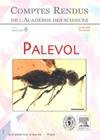西欧第一批现代啮齿动物的扩散和早期进化:来自vall - pened盆地(加泰罗尼亚)的新数据
IF 1.3
4区 地球科学
Q3 PALEONTOLOGY
引用次数: 6
摘要
现代蟋蟀起源于亚洲,在中新世早期末期分散到西欧,在那里它们迅速成为啮齿类动物的主要组成部分。本文回顾了西班牙vall本文章由计算机程序翻译,如有差异,请以英文原文为准。
Dispersal and early evolution of the first modern cricetid rodents in Western Europe: new data from the Vallès-Penedès Basin (Catalonia)
Modern cricetids originated in Asia and dispersed into Western Europe by the end of the early Miocene, where they quickly became major components of the rodent faunas. Here we review the early Miocene rodent record of the genera Democricetodon Fahlbusch, 1964 and Megacricetodon Fahlbusch, 1964 in the Vallès-Penedès Basin (Catalonia, Spain). Democricetodon is represented by four species in the studied sites (D. hispanicus Freudenthal, 1967, D. cf. decipiens (Freudenthal & Daams, 1988), D. gracilis Fahlbusch, 1964 and a large-sized undetermined species) and Megacricetodon by one (M. primitivus (Freudenthal, 1963)). The cricetid succession bears several similarities with that of the nearby Calatayud-Montalbán Basin (East-Central Spain) to the point that the same detailed local biostratigraphy could be extended to the Catalan basin. The rare presence of certain Democricetodon species (D. gracilis) and other small mammal taxa also reveal affinities with regions beyond the Iberian Peninsula and indicate that the Vallès-Penedès Basin was more humid and forested than inland Iberian basins during the early Miocene.
求助全文
通过发布文献求助,成功后即可免费获取论文全文。
去求助
来源期刊

Comptes Rendus Palevol
地学-古生物学
CiteScore
2.10
自引率
0.00%
发文量
39
审稿时长
17.6 weeks
期刊介绍:
Comptes Rendus Palevol is a fully electronic and peer-reviewed journal, with a continuous publication stream, devoted to palaeontology, prehistory and evolutionary sciences. It publishes original research results, in French or English, in the following domains: systematic and human palaeontology, prehistory, evolutionary biology and macroevolution, and history of sciences. Thematic issues may also be published under the responsibility of a guest editor. All articles published in Comptes Rendus Palevol are compliant with the different nomenclatural codes. A copyright assignment will be signed by the authors before publication.
 求助内容:
求助内容: 应助结果提醒方式:
应助结果提醒方式:


